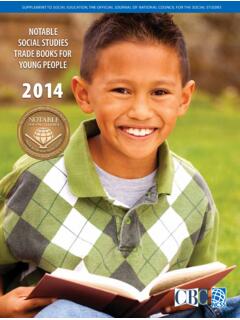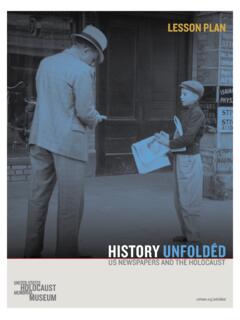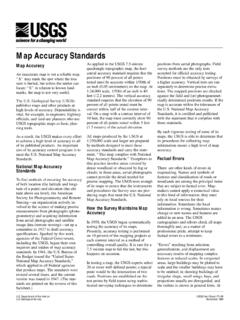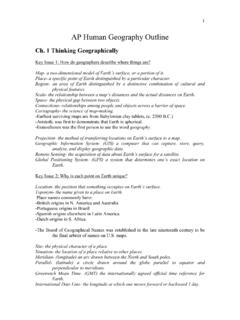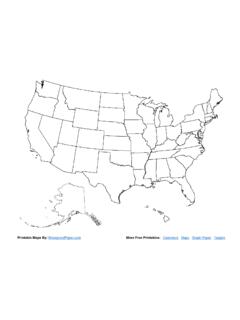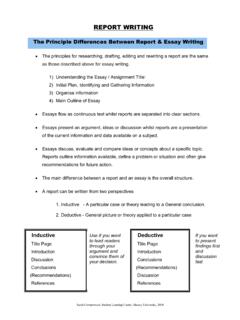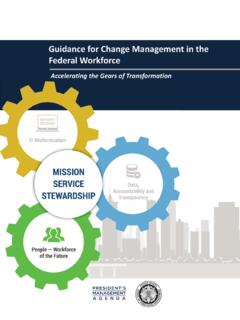Transcription of Maps and Map Learning in Social Studies
1 Since 1990, the importance of maps and other graphic representations has become even more important to geog-raphy and geographers. This is due, to a large extent, to the development and widespread diffusion of geographic (spatial) technologies. As computers and silicon chips have become more capable and less expensive, geographic informa-tion systems (GIS), global positioning satellite (GPS) receivers, and remotely sensed images of Earth from airplanes and satellites have become accessible to geography students and faculty at all lev-els. These technologies are key research and communication tools for geographers and have significantly increased inter-est in geography as evidenced by rising enrollments in university undergraduate and graduate Another indica-tion of the growing importance of maps is a rising interest among geographers, psychologists, and cognitive scientists in spatial thinking, the kind of thinking that underpins map reading and interpreta-tion.
2 Spatial thinking is the knowledge, skills, and habits of mind to use spatial concepts, maps and graphs, and pro-cesses of reasoning in order to organize and solve course geospatial technologies and their products are available to students and faculty in all disciplines, and they have become ever more common in the daily lives of more and more people. In fact, one can argue that the ability to use maps, images, and spatial technologies intelligently and critically is becoming a requirement to participate effectively as a citizen in modern society. Consider these four developments:1.
3 Travelers, hikers, hunters, and fishers frequently use GPS systems to find their locations and to assist them in getting to their destination. These systems are also becoming more common in Google, the most popular internet search utility, now offers users maps at virtually any scale desired and, recently, through Google Earth, remotely sensed images that users can view from any direction or Governments and non-governmental organizations (NGOs) typically make information available via printed and, increasingly, online maps. For example, the federal government lets online users map census data; cities and towns post their planning and land-use maps on the internet; and property tax districts post maps of tax rates and assessed val-ues on their websites.
4 NGOs are using participatory GIS or web-based GIS mapping tools to allow stakeholders to interactively explore spatial aspects of a wide range of issues, from urban neighborhood revitalization efforts to cleanup decisions at a plutonium produc-tion Static and animated maps are much more common in today s newspapers, magazines, and electronic media than Research and Practice Research & Practice, established early in 2001, features educational research that is directly relevant to the work of classroom teachers. Here, I invited geographer Sarah Bednarz and her colleagues to summarize the research on teaching and Learning with maps in the Social Studies curriculum.
5 Walter C. Parker, Research and Practice Editor, University of Washington, SeattleMaps and Map Learning in Social StudiesSarah Witham Bednarz, Gillian Acheson, and Robert S. BednarzMaps are not the whole of geography, but there can be no geography without them. In fact, well-known geographers have often defined their subject around maps and map use. In 1939, Richard Hartshorne stated, So important is the use of maps in geographic work that .. it seems fair to suggest to the geographer if the problem cannot be studied fundamentally by maps .. then it is questionable whether or not it is within the field of geography.
6 1 Fifty years later Peter Haggett expressed the same sentiment even more directly and succinctly: Geography is the art of the mappable. 2 Social Education 70(7), pp 398 404, 432 2006 National Council for the Social StudiesSo c i a l Ed u c a t i o n398they were 20 years ago. As the cost of pro-ducing and reproducing maps and images has declined, the media have increased both the amount and the sophistication of the materials they publish. These maps play an important role in both represent-ing and reproducing The well-known 2004 election map showing the red (Republican) and blue (Democrat) states (Figure 1) illustrates this.
7 The map has taken on iconic status and reinforces the erroneous view that President Bush s victory was a landslide. The population-based cartogram constructed by Michael Gastner and colleagues at the University of Michigan (Figure 2) offers a more accurate representation of the In this way, maps and graphics may play a role in legitimating or disputing specific ideologies, beliefs, and practices. These developments, and more, both allow and require modern citizens to understand spatial information pre-sented on electronic and printed maps and images. For this reason, helping students become competent users and creators of these technologies should be an important element of all of the Social Studies maps are not just for geography anymore.
8 This places a new but wel-comed burden on geography educators to ensure that map Learning and spatial thinking are taught and taught well in the Social But are they? Assessing Students KnowledgeAssessments indicate that students are not competent map users. An analysis of the 2001 National Assessment of Educational Progress (NAEP) geography exam revealed that at every level (grades 4, 8, and 12) test items that required stu-dents to use and interpret maps were the most challenging (see Table 1). At grade 4, nine of the ten most difficult items required map interpretation, construc-tion, or use.
9 For grades 8 and 12, five and seven of the ten most frequently missed questions involved GoalsOne explanation for these low scores is that few Social Studies teachers are aware of the growing importance of maps, or are Figure 2. Election Results by State in a Population : M. Gastner, C. Shalizi, and M. Newman. Maps and Cartograms of the 2004 Presidential Election Results, ~mejn/election/. Figure 1. Election Results by and motivated to teach about and with maps. Teaching about maps means providing students with the skills and understandings required to read, interpret, and produce maps.
10 Teaching with maps means using maps to help students learn key Social Studies concepts and relationships. Teaching with maps enables students to learn through maps that is, to think spatially in various reasoning and problem-solving contexts in the classroom and real A recent survey completed by mem-bers of the Texas Alliance for Geographic Education provides information about teachers attitudes towards maps, how they use maps, and how they teach map These teachers taught elemen-tary (K-5), middle (6-8), and high (9-12) school, and they ranged in classroom experience from one to 38 years with an average of almost 14 years.

